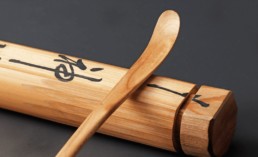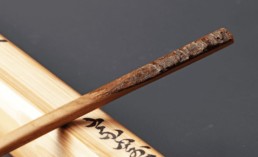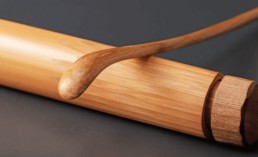A Chashaku by Tea Master Tantan-sai (Poetic Name: Kamigaki)
Artist:Tea Master Tantan-saiEra:Taisho/ ShowaPrice:SoldInquire:info@shirakuragallery.com
Here we have a very unique ceremonial tea implement made by one of the most important figures from Japanese tea culture in the past century. While most tea scoops (chashaku) are made of bamboo, this piece is fashioned from the branch of a plum tree and retains part of the bark on the handle. Fashioned by the 14th Tea Master of Urasenke, this is a very rare and interesting implement.
Matcha tea culture in Japan stretches back nearly 1,000 years, when it was first brought to its shores by Buddhist monk Eisai, who learned of it from monks in China. In the 16th century influential tea schools began to emerge in Kyoto with the advent of new philosophies and understandings of tea as a spiritual practice. Among the tea schools remaining today, Urasenke is the most widely recognized and has the largest number of devotees both in Japan and abroad. Tantan-sai (1893 – 1964) acted as the 14th Head Tea Master of this tea school and under his guidance Urasenke saw many advancements, including the dissemination of branch schools outside of Japan. Very active in the arts, Tantan-sai (also known as Mugen-sai) was known for his calligraphy, painting, and various other disciplines including wood crafting, which allowed him to fashion this unique and exquisite tea scoop that he lovingly bestowed with the poetic name “Kamigaki” (“kami” meaning “gods” and “gaki” meaning (in this case) something like “demarcation”). The most common interpretation would be to think of the tori gates that you walk through when you enter a shrine, they demarcate the boundary between our normal material world and the world of spirit. A simple interpretation of this poetic name then might be something like “gate to the gods.”
In perfect condition, this tea scoop is 7 inches in length (18cm) and comes housed in a wood tube that bears the poetic name Kamigaki and Tantan-sai’s signature. There is also an outer box that again has a description of the item, the poetic name, and the signature Konnichi-an signifying that it is from the main tea room of Urasenke.
Additional Resources:
http://www.urasenke.or.jp/texte/legacy/lineage1.html
https://www.suntory.com/sma/tearoom/
http://www.urasenke.or.jp/texte/world/e_hawaii50/e_exhibit_hwi.html







